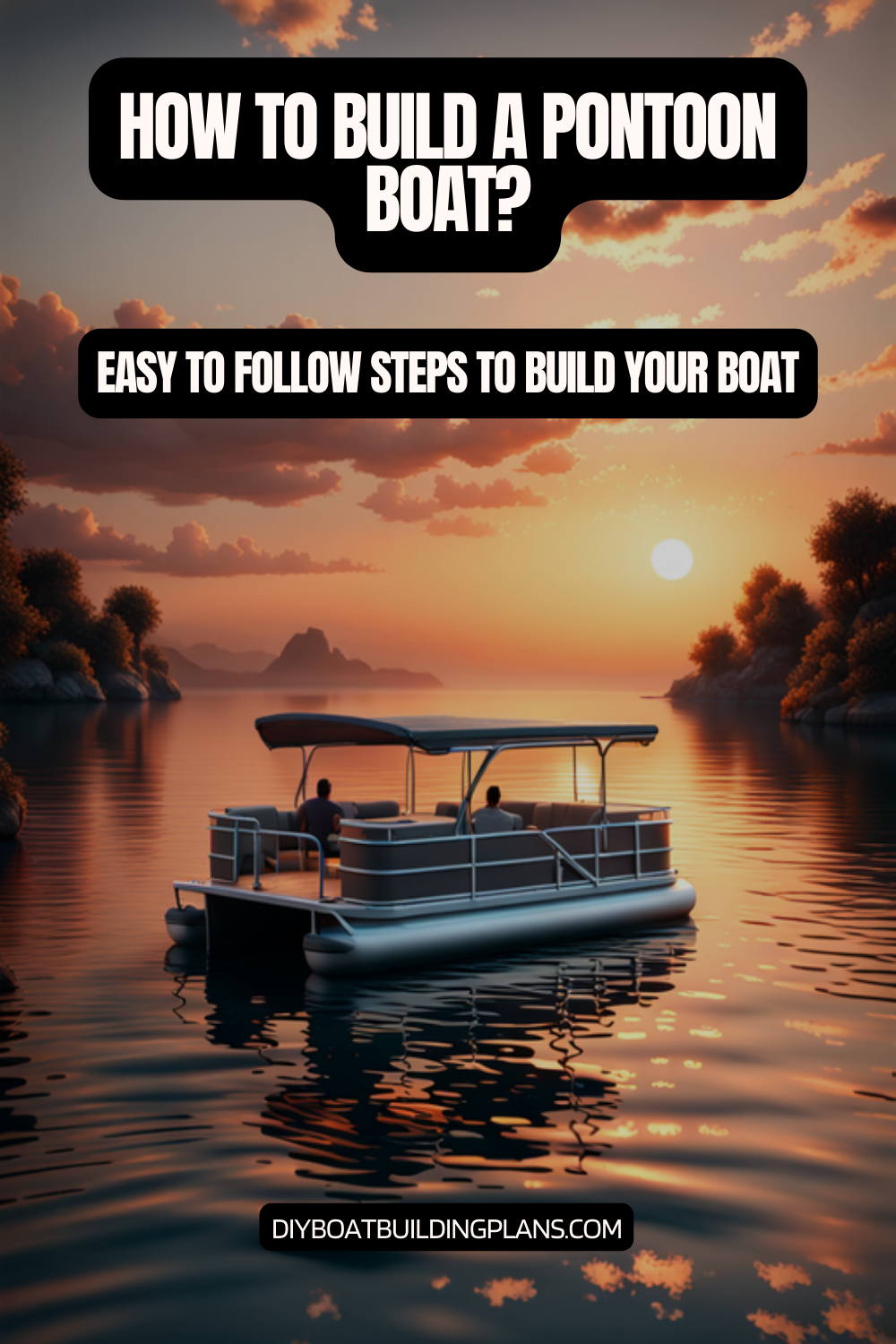Ever thought about turning your weekend into a boat-building adventure? Imagine making a custom pontoon boat with your own hands for less than a used car’s price.
Building a DIY pontoon boat is easier than you might think. With some basic woodworking skills and planning, you can save thousands. This project is both fun and rewarding.
This guide will show you how to make a small, lightweight pontoon boat. It’s great for calm waters. You’ll learn to use affordable materials and follow practical plans.
Key Takeaways – DIY How To Build A Pontoon Boat at Home
- Build a pontoon boat for under $500 total
- Requires approximately 12-15 working hours
- Create a 6’X8′ deck with 10′ pontoons
- Use affordable materials like plywood and styrofoam
- Design a boat manageable enough for two people to move

Understanding Pontoon Boats
Pontoon boats are a unique type of boat that has changed the way we enjoy the water. They offer a fun and comfortable way to explore the water, unlike traditional boats.
What is a Pontoon Boat?
A pontoon boat has a flat bottom and is supported by two or three floats called pontoons. These floats make the boat very stable and buoyant. This design allows for lots of space on the deck and makes the boat easy to move around.
Advantages of Pontoon Boats
Pontoon boats are more than just a way to get on the water. They have many benefits for those who love to boat:
- They are very stable on the water
- They have lots of room for fun and games
- They ride smoothly
- They are great for fishing, cruising, and just having fun
Different Types of Pontoon Boats
There are many types of pontoon boats, each designed for a specific use. They range from fishing to luxury and even high-speed models:
| Boat Type | Primary Use | Performance Characteristics |
|---|---|---|
| Fishing Pontoon | Angling | Stable platform, rod holders, live wells |
| Luxury Pontoon | Entertainment | Plush seating, sound systems, wet bars |
| Sport Pontoon | High-Speed Activities | Powerful engines, streamlined design |
“The pontoon boat represents the perfect blend of comfort, performance, and versatility in modern watercraft design.” – Boating Enthuasiast Magazine
Today’s pontoon boats are getting faster and more advanced. The South Bay 925CR is the world’s fifth fastest boat, reaching 114 mph. Most pontoon boats have engines that go up to 300 HP, reaching speeds of 55 to 60 mph.
Whether you want to fish, have a party, or go fast, pontoon boats are a great choice for water lovers.
Planning Your Build
Starting a DIY pontoon boat project needs careful planning. It’s about mixing creativity, technical skills, and practical thinking. This approach helps in building a successful boat.
Budgeting for Your Project
Creating a realistic budget for your DIY pontoon boat is key. You should think about these main costs:
- Material costs for frame and deck construction
- Engine and propulsion system expenses
- Safety equipment investments
- Potential permit and registration fees
“Proper planning prevents poor performance in boat building.”
Selecting the Right Design
Choosing the right pontoon boat plans is important. You need to think about your needs and skill level. Look at different designs from trusted makers like Avalon Pontoons. They have many models to choose from.
| Pontoon Boat Type | Best Use | Estimated Cost Range |
|---|---|---|
| Fishing Pontoon | Angling | $15,000 – $25,000 |
| Luxury Cruiser | Entertainment | $30,000 – $60,000 |
| Compact Recreational | Family Outings | $10,000 – $20,000 |
Required Permits and Regulations
Understanding boating laws is vital for your DIY pontoon boat. Look into local maritime laws and get the needed permits before you launch. Each area has its own rules for homemade boats.
- Check state-specific boating regulations
- Verify hull identification number (HIN) requirements
- Understand safety inspection protocols
- Confirm insurance and registration guidelines
Pro tip: Contact local maritime authorities to ensure full compliance with boating regulations before your pontoon boat build.
Unlock the secrets to building your dream boat with MyBoatPlans! With detailed plans for over 518 boats and expert video tutorials, you’ll have everything you need to create your perfect vessel. Click here to begin your journey!
Gathering Materials
Building a pontoon boat needs the right materials that can handle the sea. DIY builders must pick materials that are strong, affordable, and easy to find.
Essential Materials for Your Project
Choosing the right materials is key for a strong and safe pontoon boat. Your list should include:
- Water-treated lumber (2×6, 2×4, 2×2 dimensions)
- 30-gallon marine-grade barrels
- Oriented Strand Board (OSB)
- Marine-grade plywood
- Corrosion-resistant fasteners
Sourcing Recycled Boat Materials
Looking for affordable materials? Check out these options:
- Local recycling centers
- Construction site dumpsters
- Salvage yards
- Online marketplaces specializing in marine equipment
“The best boats are often built with creativity and resourcefulness.” – Marine Engineering Expert
Boating Safety Equipment Essentials
Don’t forget safety gear. It’s a must for safe boating:
| Safety Item | Purpose | Recommended Quantity |
|---|---|---|
| Life Jackets | Personal flotation | One per passenger |
| Fire Extinguisher | Emergency fire suppression | At least one marine-grade unit |
| First Aid Kit | Medical emergencies | Comprehensive marine kit |
Pro tip: Always check local regulations for specific safety equipment requirements before starting your pontoon boat build.
Tools Required
Building a pontoon boat needs a wide range of tools. Having the right equipment makes the project easier and more successful.
Basic Tools for Building
Every boat builder starts with a basic toolkit. These tools are essential for building a pontoon boat:
- Circular saw for cutting materials
- Power drill with multiple bit sizes
- Adjustable wrench
- Measuring tape
- Level for ensuring straight lines
- Screwdriver set
Special Tools for Precision
When building a pontoon boat, precision is key. Special tools help with accurate measurements and alignment:
- Digital angle finder
- Laser level
- Professional square
- Caliper for exact measurements
Marine Maintenance Tools
Keeping your pontoon boat in good shape requires specific tools:
| Tool Category | Recommended Tools |
|---|---|
| Cleaning | Marine-grade wire brushes, sandpaper, rust remover |
| Lubrication | Marine-grade lubricants, grease gun |
| Protection | Corrosion-resistant spray, waterproof sealant |
“The right tools can transform a challenging boat-building project into an enjoyable experience.” – Professional Boat Builder
Pro tip: Always invest in high-quality tools and maintain them properly to ensure longevity and precision in your pontoon boat construction project.
Constructing the Frame
Building a strong pontoon boat frame is key for a safe and reliable watercraft. The frame is the boat’s backbone, affecting its performance and stability.
Building a pontoon boat frame needs precision and planning. Understanding measurements and structural integrity is essential for success.
Essential Steps for Frame Building
- Select high-quality marine-grade aluminum or treated lumber
- Create a rectangular base using 2×6 lumber
- Cut precise 45-degree angles for secure frame connections
- Install support braces to enhance boat frame stability
Critical Measuring Techniques for Boat Building
Accurate measurements are vital for a well-built pontoon boat. The stability of the boat frame depends on careful construction.
- Use a professional-grade measuring tape
- Double-check all measurements before cutting
- Ensure symmetry across the entire frame
- Maintain consistent spacing between support structures
“Precision in measurement is the difference between a good boat and a great one.” – Experienced Boat Builder
Maximizing Frame Stability
Your pontoon boat’s performance relies on a strong frame. The right placement of support beams and material choice boost stability and durability.
Pro tip: Create a network frame with gaps no larger than 4 square feet. This ensures maximum structural integrity and weight distribution.
Adding the Floats
Building a pontoon boat needs careful thought about the floats. These are key for stability and how well the boat performs. Choosing the right floats is critical for your project’s success.
There are many ways to make your pontoon boat float well. If you’re watching your budget, there are smart ways to pick and secure your floats.
Choosing the Right Flotation Materials
Choosing the right floats involves a few important things:
- Durability of marine-grade materials
- Weight capacity requirements
- Cost-effectiveness
- Corrosion resistance
Securing the Floats to the Frame
Keeping your floats in place is the first step in maintenance. Galvanized metal straps are great for attaching floats to your frame.
| Float Material | Cost Range | Weight Capacity |
|---|---|---|
| Aluminum Logs | $200 – $600 | Medium to High |
| Plastic Barrels | $50 – $150 | Low to Medium |
| Fiberglass Tubes | $300 – $800 | High |
Maintenance Considerations
Float maintenance means regular checks and careful watching. Having welding skills can help with custom touches, like adding a center pod or third log for more floatation.
“A well-maintained float is the foundation of a reliable pontoon boat.” – Nautical Engineering Experts
If you’ve spent less than $2000, smart float choices can boost your boat’s performance. Spread the weight right and think about using Water Glide for better speed and stability.
Download over 500 Boat Plans. Click on the link below.
-->Click Here<--
Building the Deck
Building the perfect pontoon boat deck needs careful planning and precision. The deck is the base of your boat, affecting both its use and comfort. To build it right, you must pick the right materials, design it well, and finish it professionally.
- Choose durable, water-resistant materials
- Ensure proper frame support underneath
- Minimize seam connections
- Plan for possible motor installations
Materials for the Deck
Picking the right deck materials is key for lasting performance. Oriented Strand Board (OSB) is a favorite for its cost and strength. Pressure-treated yellow pine is also great, with a weight of about 600 pounds for a standard deck.
“The right materials make all the difference in pontoon boat deck construction.”
Designing Your Deck Layout
Deck design should focus on space and comfort. For an 8-foot wide, 16-foot long boat, plan areas for seats, storage, and paths. Make sure to leave space for motor access and frame support under each section.
Deck Finishing Techniques
Finishing your deck is more than just looks. Add non-slip surfaces for safety and use weather-resistant finishes to fight off the sea. A $33.14 aluminum compound kit can give your deck a pro polish.
| Deck Material | Cost | Weight Capacity |
|---|---|---|
| Pressure-Treated Yellow Pine | $50-$100 | 600 lbs |
| OSB Board | $30-$70 | 500-550 lbs |
Don’t forget to add safety features like handrails. Make sure your deck can handle the total weight of about 900 pounds.
Installing the Outboard Motor
Choosing the right pontoon boat motors can change your boating experience. The outboard motor is the heart of any pontoon boat. It affects performance, speed, and fun on the water.
Selecting the Right Motor
Finding the perfect outboard motor takes thought. The right motor depends on a few things:
- Boat size and weight
- What you plan to do on the water (leisure, fishing, water sports)
- How fast you want to go
Most pontoon boats do great with motors between 250 to 300 HP. These strong engines can reach speeds of 55 to 60 mph. This makes your boat fast and fun on the water.
Mounting the Motor Properly
Installing the outboard motor right is key for safety. It makes sure your boat runs well and avoids accidents.
| Mounting Consideration | Importance |
|---|---|
| Motor Height | Ensures proper water intake and reduces drag |
| Weight Distribution | Maintains boat balance and stability |
| Stern Placement | Maximizes performance and fuel efficiency |
Safety Precautions
Always put safety first when installing an outboard motor. Important safety steps include:
- Install a reliable kill switch
- Ensure proper electrical connections
- Check manufacturer’s mounting guidelines
- Use the right mounting hardware
“A well-installed motor is the difference between an enjoyable day on the water and a possible disaster.” – Marine Engineering Expert
Pro tip: Keeping your pontoon boat motors in good shape means they’ll last longer and work better. This helps avoid surprises on your water adventures.
Final Touches
Finishing your pontoon boat needs careful attention to detail. You must focus on both how it works and how it looks. The last steps include adding important accessories, painting it professionally, and testing it thoroughly.
Adding Accessories and Features
Make your pontoon boat more comfortable and useful with the right accessories. Think about adding:
- Sturdy grab rails for safety
- Convenient drink holders
- Comfortable marine-grade seating
- Wraparound windshield for better visibility
Painting and Aesthetics
Choosing the right paint is key for both protection and looks. Pick marine-grade paints that:
- Protect against UV rays
- Resist corrosion
- Stay strong against water
- Match your design’s colors
Critical Boat Testing Procedures
Do a full test before you launch to check safety and performance. Focus on:
| Test Area | Key Considerations |
|---|---|
| Floatation Stability | Check weight distribution and buoyancy |
| Motor Performance | Verify engine functionality and speed capabilities |
| Safety Systems | Inspect life-saving equipment and emergency protocols |
“A well-tested boat is a safe boat. Never compromise on thorough pre-launch inspections.”
Remember, about 90% of sport boats need careful testing and prep. By following these steps, you’ll have a pontoon boat that’s safe and ready for fun on the water.

Maintenance and Care
Keeping your pontoon boat in great shape is key. Start each season with a thorough check-up. Look for leaks, cracks, or corrosion, focusing on the recycled barrels and wooden frame.
Cleaning your boat regularly is important. Clean it well at summer’s start, focusing on areas that get dirty easily. Use cleaners made for boats to keep the OSB deck and wood safe. This makes it easier to spot and fix problems.
Storing your boat for the off-season needs careful planning. Cover it fully to keep out debris and pests. Before you store it, clean, wax, and polish everything. Take out the electronics and make sure it’s dry to avoid mold and mildew.
Make a checklist for each season. Check fuel and fluids, the battery, spark plugs, and the fuel filter. If you use it in saltwater, flush the engine after each trip. Clean it inside and out at least twice a year to stop salt damage.
Routine Maintenance Practices
Set up a regular maintenance plan. Inspect your boat’s key parts often. Check the metal straps, the deck’s strength, and look for any damage that could affect how it works.
Troubleshooting Common Issues
Keep an eye out for problems like damaged upholstery, seals, and wear. Fix any issues right away to avoid bigger problems. Make sure the wooden frame, made from treated lumber, stays strong and doesn’t rot.
Storing Your Pontoon Boat for Offseason
Choose a good place to store your boat that keeps it safe from bad weather. Use a top-notch cover to protect it from moisture, debris, and animals. Storing it right is essential to keep it in good shape when you’re not using it.
FAQ
How difficult is it to build a pontoon boat at home?
Building a pontoon boat at home is doable for those with some DIY skills. It’s all about your experience with woodworking and boat building. Using kits from Manitou or Sun Tracker can make it easier, with clear instructions.
What materials do I need to build a pontoon boat?
You’ll need water-treated lumber, 30-gallon barrels, and OSB. Also, sub-flooring, metal straps, screws, and caulk are key. You can find these at recycling centers, construction sites, or marine stores.
How much will it cost to build a pontoon boat?
Costs vary based on materials, motor, and extras. A basic boat can cost between $2,000 and $5,000. Using recycled materials and a used motor can save money. The final cost depends on the boat’s size, engine, and features.
What tools do I need to build a pontoon boat?
You’ll need a circular saw, drill, and screwdrivers. Also, wrenches, a level, square, and tape measure are essential. Marine tools like brushes and lubricants are also recommended. Make sure all tools are in good shape and right for marine work.
How fast can a homemade pontoon boat go?
With a 250 to 300 HP motor, your boat can hit 55 to 60 mph. Even racing boats can go fast, like Brad Rowland’s South Bay 925CR, which hit 99 knots in 2015.
Do I need special permits to build and use a homemade pontoon boat?
Yes, you’ll need to check local boating laws and get permits. This means registering your boat and following safety standards. Each state and area has its own rules, so research yours.
How do I maintain my homemade pontoon boat?
Keep it clean, check the propeller, and fuel lines. Fix any damage right away. Use marine cleaners and degreasers. For storage, clean it well, remove electronics, and cover it to protect it from the weather.
What safety equipment is essential for a pontoon boat?
You’ll need life jackets, fire extinguishers, a first aid kit, and a marine radio. Also, navigation lights, a horn, and a kill switch are must-haves. Always have the right safety gear and follow local boating rules.



